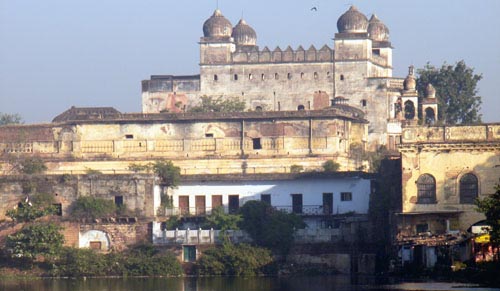Taj Mahal Palace

Information on Taj Mahal Palace (Bhopal, Madhya Pradesh) - History & Architecture
Taj Mahal Palace is located in the district of Bhopal in the state of Madhya Pradesh in Central India. Its construction started in 1871 and completed in 1884 spanning over a period of 13 years at a cost of INR30 lakhs. During those days, it was one of the largest palaces in the world. It was built for Sultan Shah Jahan, Begum of Bhopal. It is situated beside the Taj-ul-Masajid. It is actually named as Raj Mahal but the British Resident at Bhopal who were largely impressed with its beauty and architecture, advised that the palace be proudly renamed as the Taj Mahal. The queen wholeheartedly accepted the suggestion. After the successful completion of the building, the queen is said to have officially ordered a three-year-long celebration known as Jashn-e-Taj Mahal.
Taj Mahal Palace Architecture
The architecture styles and patterns of Taj Mahal largely have Hindu, Arabic, British, Mughal and French influences. The building structure comprises of 120 rooms, the savon bhadon pavilion, a hall of mirrors or sheesh mahal and a fountain like structure which simulated the direct effect of rain. It is to be noted that the main entrance is a seven-storied building structure. The palace complex of buildings has the Benazir Palace, three lakes and the Taj-ul-Masjid Mosque. In the Indo-Saracenic style, the palace has been built. The palace always gets cool winds blowing in from the lakes that are close by. At present, this particular palace has been largely converted into an archaeological museum with a good collection of antiques and weapons belonging to the periods. The interior and exterior of this palace are really a masterpiece. Most of the rooms have large windows and doors that provide good ventilation. The ceiling and floors of the palace are well-decorated with traditional patterns and style. There courtyard of the palace is dotted with attractive garden.
Taj Mahal Palace History
Sultan Shahjahan Begum was born on 29 July 1838 in Islamnagar near the city of Bhopal. She was the only daughter of Jahangir Mohammed Khan and Sikandar Begum. She was the Begum of Bhopal for two periods that is from 1844 to 1860 and during 1868-1901. During her tenure, she improved increased stake intake, tax revenue system, modernized the military system, raised the salaries of her soldiers, built dams and huge reservoirs, improved the efficiency of the police force, etc. She was groomed for state leadership from her childhood.
Sultan Shah Jahan, Begum of Bhopal has authored many books in Urdu language. She was instrumental in the construction of the Taj-ul-Masajid, at Bhopal which is considered as one of the largest mosque in India. She also planned to visit Mecca. She was a popular queen and respected by all. She largely assisted and funded to build a mosque at Woking, Surrey in the UK, the Muhammadan Anglo-Oriental College at Aligarh and construction of railway line between Hoshangabad and Bhopal. She passed away after a short illness on 6 June 1901. Later her daughter named Sultan Jehan assumed the throne.
Taj Mahal Palace Tourism Importance
Taj Mahal Palace is located in the heart of the city of Bhopal. It can be easily reached by domestic and foreign tourists. A day is largely required to go around this particular palace. Indo-Saracenic architectural style of this palace is really attractive and unique in all aspects. It is one of the sought after palace by the tourists in this state.
- Andaman Nicobar Monuments
- Andhra Pradesh Monuments
- Assam Monuments
- Bihar Monuments
- Chhattisgarh Monuments
- New Delhi Monuments
- Goa Monuments
- Gujarat Monuments
- Haryana Monuments
- Himachal Pradesh Monuments
- Jammu and Kashmir Monuments
- Karnataka Monuments
- Kerala Monuments
- Madhya Pradesh Monuments
- Maharashtra Monuments
- Odisha Monuments
- Punjab Monuments
- Rajasthan Monuments
- Tamil Nadu Monuments
- Telangana Monuments
- Uttar Pradesh Monuments
- West Bengal Monuments